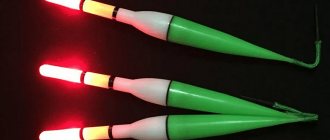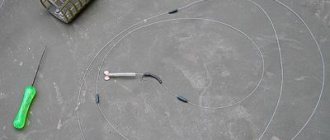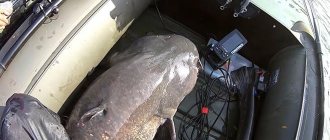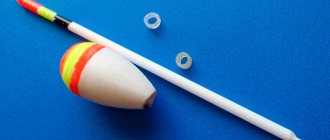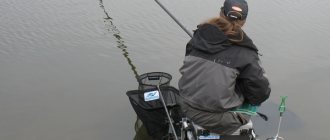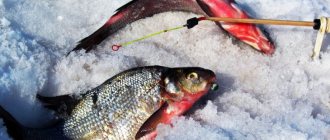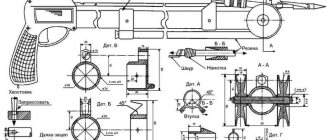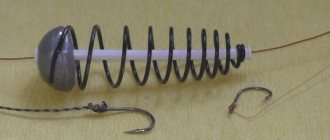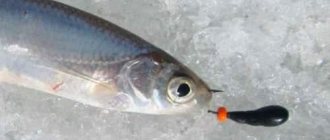DIY underwater float for catfish – Fishing selections
As the name of this rig suggests, the main feature is the underwater float. It is this that provides additional mobility to the bait or live bait (and does not serve to display a bite), which has a positive effect on their attractiveness for the main purpose of fishing.
An underwater float for catfish looks like a cylinder or an elongated ellipse (this shape makes it suitable for use both in currents and in still water), and is made of materials that have positive buoyancy.
Often this is cork, foam plastic or other polymer materials, which makes it possible to independently produce such gear. Mountings for such floats are used both with a sliding sinker and blind ones.
There are fishermen who prefer to use rather heavy stones (from 2 kilograms or more) instead of a weight. This ensures that the gear is self-hooking, but such equipment will have to be transported to the fishing site by boat.
The stone is tied with a relatively thin rope made of natural materials and attached to the equipment with a thin breaking line, which breaks when a catfish bites, and such a heavy sinker does not interfere with the process of fishing for the trophy.
This option is used infrequently, since the use of such a load is quite inconvenient and requires the fisherman to have a swimming device. Important.
The sinker can be either sliding or tightly fixed, but the float should not slide along the equipment.
Catching catfish from the shore to the bottom - tackle, bait and fishing techniques
Almost every angler sooner or later comes to the goal of catching a trophy specimen. And sometimes the most desirable prey in this case is catfish.
As practice shows, bottom tackle provides the best results when hunting catfish.
Gear selection
Depending on the terrain and fishing conditions, the following are used:
- bottom tackle with a rod;
- Donka without a rod;
Kwok and trolling are the most effective ways to catch catfish. But, unfortunately, not all fishermen have a boat, so many are forced to catch the owner of the river from the shore, using bottom gear. Well, with the right approach, coastal fishing can be very productive - you can catch a decent catch.
Catfish are caught mainly in rivers using donkeys. The most promising places for fishing are holes and exits from them. Catfish loves depth, so it is simply pointless to look for it in any other places.
Throughout the day, river monsters rest calmly at the bottom, buried in the silt, or hiding under some snags. But with the onset of dusk, catfish become more active and go hunting. Therefore, you need to catch catfish at night.
If the place is chosen well, the bites will not take long to arrive. The most important thing is that the tackle does not let you down. This, as well as the best bait for catching catfish, will be discussed below.
Tackle
Catching catfish with a donk has been practiced since time immemorial. Our grandfathers caught the mustachioed one with donkeys, and I must say, they caught it well! They made the snacks with their own hands, using improvised materials.
Wooden pegs with two wire hooks were used as a reel; an ordinary metal bell or a simple plumb line made of clay or lead acted as a signaling device.
Donka-zakidushka is a kind of catfish classic, and is still used by some anglers as the most budget-friendly and easiest option to catch this fish with your own hands.
I won’t talk about how to make a donkey for catfish in the form of a hook, because I don’t think such tackle is relevant in our time. Low cost is the only advantage of such gear over a donkey assembled on the basis of a rod and reel.
There are simply a lot of disadvantages. To learn how to cast a rig from your hand far and accurately, you need a lot of practice; there is always a risk of tangling the line while casting. It got caught on some twig, and that’s all - a beard.
At night, in conditions of poor visibility, the likelihood of a failed cast increases many times over. To ensure that the fishing line does not cling to anything, you need to pre-clean the area, which is not always possible due to some time constraints.
When fishing for large fish, there is a risk of not calculating the maximum load on the fishing line, and the catfish will tear the equipment.
When using a rod and reel, there are no such problems, so this option is definitely better, especially for a novice fisherman.
The best option is to use carp gear for catching catfish.
They have all the necessary qualities, allowing you to make long casts and confidently fight large catfish.
If your budget is limited and you can’t afford to buy carp rods and reels, you can use cheap fiberglass two-piece spinning rods with a large cast for catching catfish from the shore.
I recommend paying attention to KAIDA CROCODILE spinning rods with a length of 2.4-3.0 m. At a cheap price, these sticks have a colossal reserve of power and strength.
They can easily cast heavy equipment and forcefully pull large fish.
As for the choice of fishing line, it is best to immediately wind a braided cord with a diameter of 0.35-0.4 mm onto the spool. The well-known, inexpensive Power Pro cord is quite suitable.
Suitable rod and reel
Catching catfish on a donk with an underwater float involves using a fairly powerful rod. It must cope with strong and heavy fish, since the weight of trophies during such fishing is often measured in tens of kilograms.
Unlike when fishing for smaller fish, in the case of catfish, inexpensive Chinese fiberglass telescopic rods will most likely simply not withstand the load. Powerful spinning rods, super-heavy class feeders, as well as some carp rods are suitable for trophy hunting.
The action is preferably closer to slow - in this case, almost the entire form will tire the fish.
The reel is also selected based on the possible size of the trophy. This must be a fairly powerful device.
It is very desirable to have a baitrunner, as it allows you to safely move away from the rod without fear of losing your tackle. In the absence of such a reel, you can simply release the friction brake as much as possible, however, adjusting the operation of this inertia-free unit during fishing is quite inconvenient.
A strong fishing line or cord is also used. If you plan to catch relatively small catfish, then a diameter of 0.3 millimeters may be sufficient, while trophy specimens will require gear with a main line diameter of 0.5 or more millimeters in diameter.
Source: https://blogrybaka.com/podvodnyy-poplavok-na-soma-svoimi-rukami/
Preparation and installation of gear for catfish
Fans of catfish fishing are well aware of how unpredictable such an activity can be. Fighting giant prey requires good preparation and effort. And before going to the reservoir, the gear for catfish is selected with special care.
Choosing gear depending on the type of fishing
Being the largest inhabitant of freshwater bodies, catfish can offer strong resistance when fishing. To get it out of the water onto the shore, you need to use strong tackle.
It must withstand not only the large weight of the predator, but also suppress its jerks. The choice of fishing tool depends on the type of fishing.
Gear requirements
When going to the store to buy tackle for catfish, you should choose reliable designs that are ready to cope with any load. There are also a number of requirements that need to be taken into account:
- Rod. It uses powerful fishing rods, adapted for a long fight with a large predator. The best option is a fiberglass model, about 3 m long (if you use longer models, this will complicate the process of controlling the jerks of the fish in the last minutes of fishing). The test load should be 100-300 g for live baits and 100-150 g for artificial products.
- Coil. For catfish fishing, use a reel with a 200 m spool made of durable materials. Experts recommend buying inertia-free models for sea fishing or multipliers. Metal carp reels are suitable for the average catfish.
- Hooks. You can catch catfish with both homemade and factory hooks. The main thing is that they are made of high quality steel. The type of hooks is determined by the size and weight of the bait. So for a large bait, use a large product numbered 8-10, and for meat shells, worms and light baits take a smaller hook (No. 5-6).
- Network. Catfish fishing is carried out using a braided cord with a thickness of 0.35−0.7 mm. Unlike classic fishing line, braided line can withstand loads of up to 30-60 kg. When catching small catfish, the use of fishing line is allowed. Its diameter should be at least 0.6−0.7 mm.
- Leash. It is advisable to use Kevlar models, which have increased flexibility and resistance to strong jerks. The breaking load indicator reaches 50−150 kg. Products made from this material bind well, are not afraid of stretching and are protected from being bitten. A good alternative for a Kevlar leash is a thick fishing line, at least 1 mm thick.
From the shore
You can catch catfish from the shore using either spinning or bottom gear. The second option is considered the most convenient, but does not belong to the category of sports. It involves installing a stationary structure on the shore and waiting for a bite.
When preparing equipment, it is necessary to take into account the specifics and location of fishing. If fishing is carried out in places with an abundance of snags, stumps and other bottom debris, it is better to use a strong fishing line with a reserve.
Single models with a long shank are used as a hook, since they are less likely to get caught on snags. The diameter of the fishing line for donkey is at least 0.6 mm. The optimal weight of the sinker is 200-300 g, and the shape is oval with a longitudinal hole.
The bottom tackle is equipped with a leash 1-1.5 mm long. A good bait for catfish is a live frog. The predator is also interested in the smell of spoiled tripe.
In open water, barbel is caught from early spring until late autumn. Sometimes winter fishing for catfish is allowed, provided that the reservoirs are not covered with ice. But it is difficult to predict how the catfish will behave in winter if its activity decreases greatly during the cold season.
From the boat
The principle of boat fishing is practically no different from shore fishing. At the same time, the presence of a swimming device allows you to change the casting location in the event of a lack of bite.
To attract a trophy, you can use a clever device - “kwok” - catching catfish using this device always brings a good catch. It creates a specific sound that attracts fish from a great distance. The bait used is live bait, frog or crawler.
Spinning tackle
Spinning fishing is considered a difficult activity that involves fighting large prey. To extract a river monster from the water, you need to use powerful, functional and reliable fishing rods with good shock-absorbing properties. When assembling gear for trolling catfish, you should give preference to special models designed for this method of fishing.
Selection of wobblers
One of the most effective baits for catching catfish is a wobbler. Fish are well attracted to both floating and sinking models, and the key requirement is the depth of the product. This property is provided by the manufacturer, but the angler can change the immersion depth of the wobbler himself.
When catching catfish by trolling, you need to consider the following factors:
- Diameter of braided line.
- Distance between boat and bait.
- The speed of the boat.
The bait will be submerged to the maximum depth when using a thin line. Fans of trolling fishing prefer the following models of wobblers: Rapala Super Shad Rap, Mann's Stretch, Halco Sorcerer and Bomber Deep Down Long A.
The listed wobblers for catfish demonstrate good effectiveness due to the wide variety of colors, stable and attractive play, as well as good immersion depth. And according to experienced spinning anglers, a “bomber” wobbler for catfish is the best solution in its price category, allowing you to attract even lazy fish.
Spoons
Every angler's arsenal should include catchable lures for catfish. Particular attention is paid to thick-walled models with large dimensions and heavy weight.
The bait is slowly pulled along the bottom, causing the turbidity to rise, which creates an imitation of the movements of live prey.
Coil selection
If you are interested in how to catch catfish, you need to carefully select a reel. It uses a reinforced product with a spool capacity of up to 3000-5000. At the same time, the predator is caught with both powerful carp reels and models for sea fishing.
For catching catfish by trolling, both power multipliers and inertia-free structures are allowed.
Rod
An important element of equipment for catfish is the fishing rod. It should be as durable as possible, able to withstand strong and aggressive jerks. The optimal length is 2.7−3 m, and the test is 20−60 g. Preference is given to forms with a fast action.
Hooks
To catch catfish with live bait or artificial bait, you must use high-quality hooks. They must be made of durable materials, have sufficient size and degree of sharpening. You can use both store-bought and homemade hooks for catfish (The size of the hooks is determined by the size of the expected catch).
If you expect to catch 5-kilogram specimens, you can get by with carp hooks. Larger predators are caught with hooks numbered 5,9, 10 and larger, depending on their weight. You can't skimp on these products.
Installation
At the stage of installation of gear for catching catfish with spoons or live bait, the reel is equipped with a strong fishing cord or fishing line, 200 m long. A load is fixed at the end of the main line, and a leash and hooks are attached at a distance of 50 cm from the load.
Swivels or carabiners are used as fastening elements. Fishermen also advise installing a leash with a forged hook, instead of a single product.
Other types of gear for catfish
In addition to classic gear, homemade structures are used to catch catfish from a boat and shore. Some homemade products are superior to store-bought ones due to their ability to handle any kind of prey.
Equipment with underwater float
For many years, to catch the predator, fishermen used a clever tackle - a donk with an underwater float. Its distinctive feature is the location of the float.
Unlike classic bottom fishing, here this part of the equipment is under water, providing additional play for artificial bait or live bait.
The design is a small cylinder or an elongated ellipse, which can be used both in still water and under strong currents. The underwater float is made of materials with good buoyancy, including:
- Cork.
- Styrofoam.
- Other polymer raw materials.
It is not difficult to install a catfish tackle with an underwater float. All materials and available tools are available in the home workshop, and you do not need to use additional equipment to assemble them.
Changeover
Catching catfish in spring or autumn is carried out using a net. This design is made from a durable cord equipped with one and a half meter leashes with hooks. The tackle is pulled from one bank to the other across the river. There are bottom and top models.
The first option is equipped with an additional weight that ensures fixation of the nozzle at the very bottom. The harnesses are stretched over the water or along the surface of the reservoir so that the hooks and bait are at a distance of 30-40 cm from the water.
Spear fishing
Today, such a direction as underwater hunting is actively developing. The use of a harpoon allows you to catch a trophy barbel that is large in size and weight.
Catfish activity increases in mid-May, when the water temperature rises to +17...+18°C. During this period, predators begin to spawn, but there is an official ban on fishing in the country. You can start hunting only after spawning has completed, somewhere in early summer.
With the arrival of summer heat, the river water becomes cloudy, so finding prey in it is problematic. Experienced spearfishers consider autumn to be the best time to dive. Autumn cold improves visibility underwater, providing better conditions for your next dive.
In the fall, hunting river catfish is much easier and more effective. In addition, at this time the largest representatives of the species emerge from the pits, which makes the hunt especially exciting.
Often an underwater gun is used to catch catfish in winter. This is possible under favorable weather conditions, when reservoirs remain open from ice.
Pulse fishing rod
There are less common fishing methods that are prohibited by law, but are still used by unscrupulous fishermen. Among them is the use of an impulse fishing rod. The tackle generates an electrical impulse that affects defenseless fish, killing it instantly.
In addition to large individuals, fry and young fish float to the surface. Many of them die, but the rest are damaged and can no longer reproduce.
What homemade tackle is easiest to assemble with your own hands?
It’s not difficult to assemble homemade gear for fishing for catfish. But some options have an intricate design and require installation skills. The rest are quite simple to make, so even a beginner can make them.
Among them is the classic donka. To create the tackle you will need a strong cord, a large hook and a heavy sinker. The latter equipment is cast independently from lead or purchased at a fishing store.
Particular emphasis is placed on the quality of the fishing line. For a homemade product, use a twisted or braided cord that can withstand loads of up to 50-60 kg. The optimal fishing line length is 50−100 m.
Single but large models made of 5-6 mm strong wire are used as hooks.
It’s not difficult to set up catfish supplies with your own hands. It is enough to prepare the necessary equipment elements and connect them one by one. A good homemade product allows you to catch catfish in winter and summer with equal efficiency.
Best lures
When choosing bait for a hook, you need to remember the myopia of the river monster. Possessing poor eyesight, the catfish demonstrates a good sense of smell, hearing and sensitivity of the sides, with which it detects any fluctuations in the water column.
For fishing, you should use moving baits with an intense smell.
Medvedka
Experienced fishermen have been catching barbel with a mole cricket for a long time. The attachment has some advantages that make it better than other options.
Firstly, it is interesting only for catfish, and causes a strong appetite in the predator. Secondly, unlike the crawler, it can stay in the water at any time of the day or night. The river giant responds well to both living and dead mole crickets.
The bait is put on face down. To do this, you need to take it by the body and pierce it with a hook in the neck area with the sting down. Given the aggressive behavior of mole crickets, they cannot be stored in the same container. Each animal is placed in a separate jar of grass and transferred to the refrigerator.
Liver
One of the most effective baits for catfish is chicken liver. However, it does not hold well on the hook, so it attracts fish for a short time. To improve the fixation of the liver, it can be frozen in the refrigerator. The melted product can be placed in a nylon stocking so that it does not crumble in the water.
Soap
In Soviet times, catfish were caught using laundry soap. Then it was created on the basis of animal components without adding aromatic additives.
The composition of modern soap has changed, so the chances of catching a barbel on a piece of such a substance are minimal. In some conditions, the bait justifies itself, provoking the catfish to bite.
Frog
A frog is a classic bait for any catfish fishing. Bait can be found in any pond, but it cannot live long without air underwater. Therefore, before going fishing, it is better to stock up on a large number of frogs in order to change them as activity decreases.
Catching catfish with a donk, feeder, spinning rod, “kwok” and other mentioned gear is always accompanied by unforgettable emotions and a surge of adrenaline.
You never know what kind of monster might be on the hook or how long it will take to fight it, so the time and effort spent is justified by the trophy catch.
Source: https://ribaku.info/snasti/na-soma-2
Donka with an underwater float for catching catfish - advantages and features of the gear
For fishermen in the middle zone, catfish is one of the most coveted trophies. This is primarily due to the fact that this fish is the largest inhabitant of our reservoirs.
Trophy hunters often catch specimens weighing 20, 30, and sometimes more kilograms, and such fish can bring a lot of pleasure when fishing. A variety of gear is used for fishing for catfish - spinning rods, bottom fishing rods, hooks and much more.
However, artificial baits for the river giant often turn out to be unattractive;
This fish happens to be a by-catch, and even then relatively infrequently. An interesting option is a donka with an underwater float. This option has a number of advantages compared to conventional equipment.
Tackle design features
As the name of this rig suggests, the main feature is the underwater float. It is this that provides additional mobility to the bait or live bait (and does not serve to display a bite), which has a positive effect on their attractiveness for the main purpose of fishing.
An underwater float for catfish looks like a cylinder or an elongated ellipse (this shape makes it suitable for use both in currents and in still water), and is made of materials that have positive buoyancy.
Often this is cork, foam plastic or other polymer materials, which makes it possible to independently produce such gear. Mountings for such floats are used both with a sliding sinker and blind ones.
There are fishermen who prefer to use rather heavy stones (from 2 kilograms or more) instead of a weight. This ensures that the gear is self-hooking, but such equipment will have to be transported to the fishing site by boat.
The stone is tied with a relatively thin rope made of natural materials and attached to the equipment with a thin breaking line, which breaks when a catfish bites, and such a heavy sinker does not interfere with the process of fishing for the trophy.
This option is used infrequently, since the use of such a load is quite inconvenient and requires the fisherman to have a swimming device.
Important!
The sinker can be either sliding or tightly fixed, but the float should not slide along the equipment.
Choosing gear for catching catfish
Catfish is a large predator that prefers to swim in depressions in rivers. To catch prey, you need to coordinate the type of gear with the fishing location; it must either reach the predator’s habitat or have the ability to lure prey out of the hole. Another important factor to consider is catfish bait. In each case, the key requirement is strength, because only a reliable rod will help you catch a trophy specimen.
Catfish. Bottom tackle with an underwater float for catching catfish (TEST 60kg). Fishing for catfish and pike
1 000.00 ₽
Classic bottom tackle
for catching catfish it is a tackle with a load of about 300-500 grams, with a powerful main cord and one or two leashes. Donka is brought in by boat; large live bait weighing 300–400 grams, frog, offal, etc. can be used as bait.
For catching catfish
It is necessary to use materials with a breaking load of at least 50 kg. The catchability of the gear greatly increases if the bait is lifted from the bottom, which is achieved using a system of underwater floats.
When using live bait, the float constantly pulls it upward, thereby preventing it from hiding at the bottom and at the same time forcing it to actively move. Floats can be placed either on the main cord or directly on the leash; the size and number of floats depends on the fishing conditions, the strength of the current, the depth of the reservoir, and the size of the bait.
Modern fishing tackle
, used for fishing mainly for
catfish
, as well as pike, is an installation in the form of a durable leader material with a diameter of 1.3 mm and a length of 2 m, at one end of which powerful hooks are tied, the main one is single and the safety hook is double, and at the other end there is a power carabiner.
All knotted and knotless connections are neatly sealed with silicone casings. An underwater float is installed 15cm from the hooks, which serves to ensure that the nozzle is above the bottom. Depending on the size and weight of the bait, the number of floats can be increased or decreased.
The float should not slide, and is secured using a system of stoppers made of beads and a clasp. Especially on reservoirs with a current, this type of donk has many advantages.
When using worms, dead fish, or a long strip of fish, the bait will play attractively in the current, while spreading the scent much more effectively than bait lying on the bottom.
Catfish. Bottom tackle with an underwater float for catching catfish
This tackle is made exclusively from high-quality materials, which allows, with certain skills and experience, to catch catfish
up to 100kg
Set: Lead material
- CULT Catfish Leader diameter 1.
3mm, length 200cm, breaking load 135kg (color yellow or light brown) Single hook
— 1 pc Owner No. 9/0
Double hook
— 1 pc Owner No. 5/0
Underwater float
— 1 pc impact-resistant, low deformation, with a displacement of 200 g
Inserts for the float
— 2 pcs made of dense wood coated with varnish.
Restrictive plastic beads
- 2 pcs
Float stopper
- 2 pcs
Power carabiner
- 1 pc Owner breaking load 60 kg
Silicone cambric 5mm*4mm
- 15cm
Silicone cambric 5mm*4mm
- 5cm
Silicone cambric 5mm*4mm
- 4cm
Silicone cambric 4mm*3mm
- 3cm
Bead with swivel and carbine
— 1 pc.
Instructions
— 1 pc.
Packaging
— 1 pc.
Rice. Diagram of catfish gear with an underwater float
Catfish
fully equipped and ready to use, float is removable
Classic bottom tackle
for catching catfish it is a tackle with a load of about 300-500 grams, with a powerful main cord and one or two leashes. Donka is brought in by boat; large live bait weighing 300–400 grams, frog, offal, etc. can be used as bait.
For catching catfish
It is necessary to use materials with a breaking load of at least 50 kg. The catchability of the gear greatly increases if the bait is lifted from the bottom, which is achieved using a system of underwater floats.
When using live bait, the float constantly pulls it upward, thereby preventing it from hiding at the bottom and at the same time forcing it to actively move. Floats can be placed either on the main cord or directly on the leash; the size and number of floats depends on the fishing conditions, the strength of the current, the depth of the reservoir, and the size of the bait.
Modern fishing tackle
, used for fishing mainly for
catfish
, as well as pike, is an installation in the form of a durable leader material with a diameter of 1.3 mm and a length of 2 m, at one end of which powerful hooks are tied, the main one is single and the safety hook is double, and at the other end there is a power carabiner.
All knotted and knotless connections are neatly sealed with silicone casings. An underwater float is installed 15cm from the hooks, which serves to ensure that the nozzle is above the bottom. Depending on the size and weight of the bait, the number of floats can be increased or decreased.
The float should not slide, and is secured using a system of stoppers made of beads and a clasp. Especially on reservoirs with a current, this type of donk has many advantages.
When using worms, dead fish, or a long strip of fish, the bait will play attractively in the current, while spreading the scent much more effectively than bait lying on the bottom. By connecting the end of the main cord with a weight of 300-500 grams and attaching a catfish to the cord (the distance to the bottom weight should be approximately half the depth of the reservoir), you can attach the bait, bring the tackle on the boat and start fishing.
Photo. Appearance of bottom tackle with an underwater float for catching catfish and pike
Source: https://zerlica.ru/product/somovnik-donnaya-snast-s-podvodnym-po/
Choosing gear depending on the type of fishing
An ancient and invariably effective method of fishing is donka. The cord is fixed to a bush or tree. Catching catfish from the shore is mainly done with a donkey, and it shows the best results at night.
Another popular method is the use of girders, which are similar to the donka, but make it easier to catch large baits: frogs, live bait, etc. Another type of gear for catfish from the shore is a spinning rod, but it is effective in the presence of holes not far from the shore. If you find a hole, fishing promises to be productive. For spinning, take a powerful 3 m rod and a spinning reel. Effective baits – jigs and spoons.
Trolling fishing is gaining popularity in Russia; it will require a baitcasting reel, spinning rod, braided line and wobblers for deep sea fishing.
An additional ancient version of the tackle for catching catfish from a boat is the kwok. During quoting, special sounds are created that attract fish. The approaching predator willingly takes the bait. To use this technique, you need a rod with an attached reel or just fishing line.
How to catch catfish using an underwater float
Catfish is always a desirable trophy for a fisherman. After all, large specimens can reach 30 kg or more. And defeating such a predator requires dexterity and skill. Various methods of catching are used - hooks, spinning rods, donkeys. The latter is considered the most effective.
Therefore, in this article we will look at the features of catching catfish with an underwater float using bottom tackle, how to make such a device yourself and use it in practice.
What parts does the structure consist of?
The main distinguishing element is the underwater float. In this case, it does not display the bite, as is customary, but provides the necessary mobility of live bait or live bait in the current.
Thus, it becomes much more interesting for the chosen object of fishing - catfish. Comes in the form:
- cylinder;
- elongated ellipse.
The latter is considered universal because it is excellent for fishing both on the river and on the pond.
The raw materials used are cork, foam, polymers and other types that are characterized by good buoyancy.
The availability of materials allows you to easily make such a float with your own hands at home.
The photo clearly shows the main parts of the bottom equipment with an underwater float.
The weight is mounted using a sliding or blind method. Often, fishermen replace the standard sinker with heavy stones (weighing up to 2 kg), which guarantees self-hooking. But this option is only appropriate if the fisherman has a boat. The stone is wrapped with a thin cord and attached to the main tackle with a thin fishing line. When bitten, it breaks and does not interfere with fishing for the trophy.
As for fishing line, it is recommended to take braided line with a diameter of 0.32 mm or monofilament with a diameter of 0.5 mm.
The length of the leash can vary from 1.5 to 2.5 m. Swivels and fasteners are selected as strong as possible.
On top of the stone there is a leash through which a float is threaded. At the end there is a tee (hook) for attaching live bait or live bait.
The large length of the leash allows the baitfish to behave naturally in the water, which will not arouse suspicion among the attacking predator.
When preparing for catfish fishing, the rod is selected as powerful as possible. Therefore, cheap Chinese-made telescopic fishing rods made of fiberglass are not suitable for such purposes.
It would be optimal to use imported spinning rods, individual models of carp and super-heavy-class feeder rods.
The type of formation is close to slow, in order to tire the catfish faster.
This type of equipment requires the use of a reliable sinker so that large live bait does not drag the entire equipment with it. To catch a heavy catfish, the weight of the fish can reach 300 g.
We take a rod 3 m long, casting weight – 100-400 g.
The reel must match the selected tackle. Type - multiplier, inertia-free with a large spool so that it can freely fit, for example, 200 m with a diameter of 0.4 mm.
It is recommended to have a baitrunner - a lever, the lifting of which allows the fishing line to unwind freely from the reel. An alternative is a high-quality friction brake.
Effective baits
Experienced fishermen have noticed that if there is no carp or carp biting for several days, then you should try your luck in catching a catfish. Because, hunting for food, the predator scares away peaceful fish.
It is worth paying attention to the quality of the bait in order to lure the long-awaited trophy to the desired area of the reservoir. Chopped, whole worms or chicken giblets will do. They are mixed with clay and soil and formed into balls. The cast is performed within the radius of the fishing point.
It should be borne in mind that the future catch depends on the size of the bait. If you want to catch not a small catfish, but a weighty beauty, the bait must be appropriate.
The range of favorite catfish dishes is quite large.
The most popular options include:
- bunches of leeches, crawlings;
- pieces of fish;
- frogs;
- chicken offal (liver, heart, intestines);
- fry of roach, crucian carp, sebel;
- crayfish meat;
- caterpillars;
- mussels;
- locusts, mole crickets.
Fishing for catfish from the shore
If you are not afraid of experiments, then you should try to bait:
- furry crab meat;
- cuttlefish rings.
The latter works well when installing float equipment. The unusual smell and appearance of the rings are interesting for catfish.
This predator is a heat-loving individual, although it loves to live in the depths. Found in quiet deep-water rivers and large ponds.
Loves the following areas of the reservoir:
- with large vegetation in the form of reeds and water lilies;
- under snags;
- deep holes, whirlpools;
- debris of branches.
Recommended time for fishing with a donk with an underwater float is late evening, night. That's when the catfish goes hunting.
At night, the predator can be caught even from the shore in shallow water, since frogs live there - one of its favorite types of food.
July and August are considered the catching months.
In cool weather, it is better to fish from a boat, throwing tackle to the entrance of holes or under snags.
The creation process is not complicated, so even beginners can handle it.
As a material, you can take a piece of foam rubber, light wood, or cork. The latter is the most convenient to take, since such a workpiece does not need to be turned and shaped. You will have to tinker with even dense polystyrene foam.
Subject to painstaking work, a homemade float is not inferior in appearance and catchability to store-bought counterparts.
Let's look at an example of creating a float from a cork plug.
Procedure:
- If necessary, give the cork a streamlined shape. We do this with sandpaper.
- We take a used firefly or a small-diameter plastic tube (from Chupa Chups).
- We drill a hole through the plug, the diameter corresponding to the tube, that is, the future antenna.
- We thread a firefly through it. An ideal option when it goes in tight.
- We stretch the leash through the workpiece and install the hook.
Depending on the float capacity you want to achieve, the cork plugs can be divided into halves or several pieces can be connected at the same time.
Finally, the finished product along with the antenna is painted with a bright-colored varnish and a waterproof marker.
Creation time – no more than 15 minutes. Therefore, in order to save money, you can make underwater floats for catfish at home, without making much effort.
Fishing tactics
Fishermen advise using an installation method, thanks to which hooking can be done almost immediately. Its essence lies in the fact that live bait is attached to a tackle with a standard hook and tee.
We pierce the upper and lower lips of the fish with a regular one, and we hook a triple one in the area of the caudal fin. We use a steel wire leash to prevent other predators from biting it ahead of time. Next, the standard float installation of the equipment is carried out.
The catfish is such a predator that you try to catch it alone. Carrying out high-quality fishing for a heavy predator yourself will cost the loss of a trophy or equipment. Therefore, it is better to always take a partner with you.
If you have a fish on your hook, then the main task is to exhaust it and drag it ashore without strength. In the case when the catfish tries to hide at the bottom in the snags, try knocking with a stick. This fish is shy and will look for a way back out.
For fishing, a landing net or hook and thick construction gloves will be useful. The latter are a guarantee of the integrity of hands and fingers.
It is believed that you need to pull a catfish ashore by its mouth. Place your thumb in the mouth and grab the outside of the lower lip with the rest. You should not do this with bare hands - there is a high risk of cutting yourself on sharp teeth or driving a hook into your finger.
You will find other interesting nuances of catching catfish on an underwater float in the video at the bottom of the article.
Advantages of choice
According to fishermen, such equipment provides the following advantages:
- Preventing frequent overlapping of the fishing line and tangling of the gear.
- Natural behavior of live bait in the water due to the long leash length.
- Factory models of underwater floats have built-in noise capsules, the sound of which can lure a predator from a great distance.
- The ease of assembly, installation and availability of materials allows you to make them yourself in unlimited quantities.
- Baits like leeches and crawlers will be much more attractive to catfish with this type of equipment, especially in a body of water with a current.
Using bottom gear with an underwater float provides greater chances of catching than with standard methods. The rest depends on the right place, time, bait and, most importantly, the skills and patience of the fisherman.
Source: https://intellifishing.ru/lovlya/kak-lovit-soma-podvodnyy-poplavok
Catching catfish on a donk - photo and video guide
Every fisherman dreams of catching a very big fish. And today, in our rivers and reservoirs, the largest representative of the ichthyofauna is the catfish.
You can catch catfish with a donk, which can also be used to catch large live bait, which can later become bait for large catfish.
Catching catfish with a donk has an undeniable advantage over other methods of catching catfish. The number of bottoms can be large, so you can fish a fairly large area and find out especially promising places where catfish live.
Catching catfish on a donk in spring and summer is almost identical, try different baits. Use a bunch of worms more often in the spring.
The authorship of the design diagram for bottom gear with a float is www.euro-som.de.
Donka for catfish can be either with or without a rod.
Choose a strong rod with a powerful blank, since sometimes you have to resort to forced fishing. For catching catfish on a donk, special carp or sea rods are suitable. The same goes for coils.
Powerful inertia-free models of size 4000 with a large spool are best suited for equipping a donkey.
The thickness of the fishing line depends on the intended trophy. It can be braided or monofilament, the main thing is that the breaking force is greater than the weight of the catfish. Many anglers use 1 mm fishing line for bottom fishing without a rod.
The weight of the sinker depends on the strength of the current and the depth of fishing. If on a reservoir with standing water 20-50 g is enough, then for a large river - 100-200 g.
Hooks are selected to match the bait; they must be large and strong.
Professionals talk about how to catch catfish on a donk, what the equipment looks like and why it has a float in the following video.
Catfish are omnivorous fish, but their diet changes with age.
For small catfish, the best baits are:
Larger individuals feed on:
- frogs;
- small fish;
- crayfish.
Giant catfish eat:
- mice;
- large fish;
- waterfowl;
- small animals.
In addition, the fisherman should take into account that the catfish performs the function of an orderly for reservoirs and rivers. He does not disdain food with a “flavor”, and, having a good sense of smell, senses such food from a great distance. That’s why experienced bait fishermen deliberately spoil baits so that they have a rotten smell.
Fishing for crayfish
When studying the stomach contents of caught catfish, fishermen often find crayfish shells. This suggests that such bait will be a real delicacy for the fish.
The most difficult part of fishing with this bait will be finding the crayfish. Some fishing stores sell crayfish, and if you can’t buy it, you have to catch bait with claws using crayfish traps.
You can adapt a regular lift for catching fry by tying an appetizing bait, for example, a frog roasted over a fire, in the center of the net.
about catching catfish with kwok in the extensive guide on our website. You will learn how the tackle is constructed, how to properly make and use the quok in practice.
Catching bream on a feeder - how to catch large live bait for catching catfish and just a trophy broad-backed giant.
List of gear needed for catfish fishing.
Fishing with a frog
Frog is one of the most popular baits for catfish. They hook it by the hind legs with the sting up.
To prevent the bait from being too active, you can use a double hook, placing the frog on both legs. Then she will only crawl along the bottom. The easiest way to catch frogs is in the evening, when it gets dark, and to ensure that the jumping frog does not offer resistance, use the following proven method:
Having found a frog, you need to point a flashlight beam at it, after which you can pick up the frog with your hand. You can use a landing net to catch frogs.
Fishing with a worm
It is best to start catching catfish with a donkey with such a simple bait as a worm. To do this, a bunch of any worms or crawlers is strung on a large hook with a long shank.
Of course, it is unlikely that you will be able to catch a trophy fish, but you will be able to get acquainted with the habits of catfish. The donk can be equipped with two hooks, and a feeder can be mounted to attract fish.
The bait will be a mixture of earth and chopped worms. Often the by-catch includes fish such as ide, bream, and perch.
Fishing with live bait
Since catfish is a predatory fish, it can also be caught using live bait. Fish of different sizes fall prey to catfish. Fishing with live bait is carried out at night; there are usually bites on half of the installed bottom gear.
Any fish caught during the day is suitable as live bait. You can bait a fish on a hook by the lip or the back.
Fishing for crucian carp, what baits and bait to use, how to look for a place and the secrets of a good bite in the guide on EarlyUtrom.com.
Everything about carp fishing, from fishing methods to baits and bait.
About catching crucian carp with a float rod in the article about mixing bait, the best bait and choosing a promising fishing spot.
Finding a place to catch catfish
It is necessary to catch catfish on a donk in deep holes. You can find them on sharp bends of the river by making several test casts. Having a boat with an echo sounder will make finding a fishing spot much easier. Another way to find a catfish den is to tactfully ask local fishermen.
The area adjacent to the pit is also promising for fishing. Usually catfish hunt at the same points. So, having figured out where the fish are coming out in one night, you can safely go fishing here next time. Some of the donks should be placed under trees, near reeds and water lilies.
Features of catching catfish from the shore
When bottom fishing from the shore, you should adhere to the following tactics. First, the most promising places for fishing are selected. The fisherman spends most of his time in such places.
The rod must be securely installed on stands, the reel clutch must be loosened. The tip of the rod, which is equipped with a firefly or bell, acts as a bite alarm.
Be sure to provide an area for landing large fish before dark.
In local places you can use donks without rods. It is only important to securely fasten the fishing line to a suitable support (bush, tree).
Catching catfish with bottom tackle from a boat has its pros and cons.
The advantages include being close to the fishing point, accurately delivering the bait, and using short tackle with a thinner line.
The disadvantage of fishing is the awkward position of the fisherman, the restrictions when fishing at night, and the difficulty of landing trophy fish. Going out to catch catfish on a rubber boat alone is very risky. If you take a large catfish, then the riding experience will not be the most pleasant.
Source: https://ranoutrom.com/sposoby-lovli/som/donka.html
Spinning tackle for catching catfish
Catching catfish on a feeder is complicated only by serious loads due to the enormous weight and energy of the fish. When choosing, the emphasis is on reliability, power, functionality and shock-absorbing characteristics.
Features of the catfish tackle with a float:
- It is better to take a rod with a fast action, strong and relatively long (optimally 2.7-3 m). The test is selected within the range of 20-60 g;
- Braid is used instead of fishing line;
- catching catfish is best done with a reinforced reel – 3000-5000;
- fishing line for the leash - about 30-40 cm.
Today there are many varieties of spinning bait, but to catch the desired prey the following options are used:
Read more
How to catch catfish from the shore?
- wobblers. Each has its own leader horizon, which is taken into account even before throwing the gear. It is advisable to drive the wobbler as smoothly and relatively slowly as possible;
- jigs. Made of silicone and ideal for attracting large specimens in dark places at great depths. Wiring is performed in two main styles: stepped (used when casting), uniform (when trolling);
- spoon. Catfish are caught on large, thick-walled varieties. The spoon is slowly dragged along the bottom, this creates cloudiness in the water, as if living prey is swimming.
In gastronomic terms, this predator can be either quite unpretentious or a complete gourmet.
Spinning fishing differs depending on the time of year:
- spring. Active biting begins after the water warms up to 10-12°C, then it rises from the wintering pits and begins hunting. Promising areas are exits from pits (especially if there is an abundance of snags and silt) and secluded areas with bushes and fallen trees without sunlight. Fishing at depth is easily done using wobblers and spoons, they are carried out slowly and smoothly. Jig varieties are carried out in steps, tapping on the bottom;
- summer. Predatory fish often hunt from shelter: holes, recesses, they are often found near dams. Catfish are not group fish; they are often found alone. In hot weather, it is better to fish during the evening and morning dawn. Promising baits - wobblers, spoons with uniform wiring;
- in the fall. Behaves especially predictably. When cold weather approaches, it does not move far from the hole in which it winters. In autumn it is especially voracious, as it prepares for hibernation and increases its fat reserves. All efforts of fishermen are focused on deepening; now it is optimal to use large jigs and wobblers;
- winter. When the temperature drops to 7°C, it will not be possible to obtain prey, since it goes into suspended animation and is absolutely indifferent to any external stimuli.
Donka with an underwater float for catching catfish - advantages and features of the gear - Website about
This time we will talk about floats, which are called “underwater”. It would be more correct to classify them as bottom-based, and call them “sinkers with a float.” This is not a float at all, since it does not perform one of the main functions of a float - to show bites. But it performs another important function, namely, it holds the hook with the bait at the desired level.
Fat crucian carp from the “swamp”. Andrey Yanshevsky.
There are many cases of free assignment of one name or another in fishing gear. And this is just another example. But this doesn’t make the fish bite any worse. And fishermen understand each other perfectly when they talk about “sticks”, “toads”, “devils” or “stinkers”.
The design under discussion, which I dare not call it a float, is a tube from a feeder trough. On the long arm is a spindle-shaped body made of rigid foam polymer.
| Submersible floats are available in two sizes. Andrey Yanshevsky. |
The design is attached to a sinker or feeder using a fastener.
Under the influence of the weight of the bait on the hook, the float part tilts lower.
The distance to the hook is adjusted using a stop knot with two silicone stoppers on the line. If the feeder is heavy, then you have to install a swivel, otherwise the stopper gets knocked down during casting.
You can make the adjustment so precisely that the bait will only touch the bottom, but not sink into the mud. This adjustment of the position of the bait is very important when fishing in heavily silted areas. Carp and tench, sensing the smell of bait, will dig through the mud, but crucian carp and bream are unlikely to do so.
| Cupid and crucian carp love bait hanging above the bottom. Sergey Khrapunkov... |
The bait is easy to lift above the bottom, which is important when catching crucian carp and carp.
It is important that the light bait, after casting, will lie on the feeder or hang above it. It all depends on how to adjust the length of the leash.
It follows that the design always works well if the fish approaches the feeder and nibbles food from it. This behavior is very typical for bream and ide.
Equipment with an underwater float is ideal for fishing in heavily overgrown reservoirs, when you need to throw the bait into a window of vegetation, and when the bottom is covered with a continuous layer of filamentous algae or elodea. In this case, it makes sense to make a leash at least half a meter long. The float will not allow the sinker to pull the leash into the thickness of the bottom vegetation. The bait will lie on the vegetation and large crucian carp can find it.
| This is what the float looks like underwater. Andrey Yanshevsky. |
When fishing in the current, it makes sense to make a leash (the distance from the hook to the float) of such a length that the bait plays in the water column. This is how they catch roach and silver bream.
Each time the optimal leash length has to be selected experimentally. If a feeder is used, the length of the leash can be minimal. In the case of using a sinker, it makes sense to make a leash up to one and a half meters long.
It is very interesting to use this design in a “running” donk in a powerful current. In addition to sharply reducing the number of hooks, the float oscillates under the pressure of the current and gives the bait additional play.
In most cases, a feeder feeder is attached to the structure, but there is a special case of using an “underwater float”. This is live bait fishing.
| In grass, an additional leash is used. Sergey Khrapunkov. |
It is quite possible that the design of the underwater float was created specifically for fishing with live bait.
| Convenient live bait equipment. Sergey Khrapunkov. |
Let’s imagine a case when a predator does not walk along the irrigation area, where it can be caught with a spoon, and does not stand on the edge where the jig is working, but parades along the dump. To be more precise, at some periods of the day it climbs the slope to the upper edge. That is, it moves towards the hunting grounds.
| The equipment can be moved along a slope. Sergey Khrapunkov. |
When exactly this happens, the predator himself does not know.
Chasing mugs over a dump in the current is not an easy task, and besides, it’s very easy to miss a pike perch or catfish crawling upward. Placing classic donks with live bait means deliberately dooming yourself to dead hooks. After some time, the bait will stop fighting the current and lie to the bottom.
An underwater float may be a way out of the situation. The float always keeps the bait above the bottom. This opens up a real opportunity to catch a dead fish that will play in the current. Just don’t lose sight of the fact that live bait should not exceed a certain size. That is, it should not be so massive that it “drowns” the underwater float and falls to the bottom.
I would like to note that this tackle is unfamiliar to our fishermen and new interesting ideas on its use will certainly appear. We are waiting for the results.
Andrey Yanshevsky September 2, 2021 at 1:50 pm
Source:
When should you prefer fishing with a half-bottom?
A half-bottom is great for short-term fishing (without long casting), fishing for flooded coastal cramps and various “strong” places where various fish like to stand, from ruffe to catfish. In such places it is difficult to turn around with a feeder - snags and constant breaks in the gear will torment you, although even when fishing with a half-bottom such troubles cannot be completely ruled out. Hooks are also present, but much less frequently; moreover, this is a simpler and cheaper tackle. And the feeder is inferior in mobility, but successful fishing of coastal snags most often involves walking fishing. This kind of fishing is unique in its own way and is a convenient way of exploration and active search for promising points.
When fishing with a half-bottom and during active movements, it is unnecessary to feed the fish; this only binds the angler to the place. And if you fish actively and move around a lot, you can catch coastal cramps and rubble, and move on to the next ones - during the day you can cover a significant area of the coastal strip, stopping only in the coolest areas.

